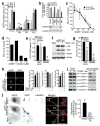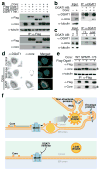Efficient hepatitis C virus particle formation requires diacylglycerol acyltransferase-1
- PMID: 20935628
- PMCID: PMC3431199
- DOI: 10.1038/nm.2238
Efficient hepatitis C virus particle formation requires diacylglycerol acyltransferase-1
Abstract
Hepatitis C virus (HCV) infection is closely tied to the lipid metabolism of liver cells. Here we identify the triglyceride-synthesizing enzyme diacylglycerol acyltransferase-1 (DGAT1) as a key host factor for HCV infection. DGAT1 interacts with the viral nucleocapsid core and is required for the trafficking of core to lipid droplets. Inhibition of DGAT1 activity or RNAi-mediated knockdown of DGAT1 severely impairs infectious virion production, implicating DGAT1 as a new target for antiviral therapy.
Conflict of interest statement
The authors declare no competing financial interests.
Figures


Comment in
-
Diacylglycerol acyltransferase-1: a critical host factor for hepatitis C virus assembly and potential new drug target.Gastroenterology. 2011 Apr;140(4):1345-7. doi: 10.1053/j.gastro.2011.02.037. Epub 2011 Feb 24. Gastroenterology. 2011. PMID: 21354164 No abstract available.
-
Triglyceride synthesis and hepatitis C virus production: identification of a novel host factor as antiviral target.Hepatology. 2011 Mar;53(3):1046-8. doi: 10.1002/hep.24177. Hepatology. 2011. PMID: 21374668 No abstract available.
Similar articles
-
The triglyceride-synthesizing enzyme diacylglycerol acyltransferase 2 modulates the formation of the hepatitis C virus replication organelle.PLoS Pathog. 2024 Sep 6;20(9):e1012509. doi: 10.1371/journal.ppat.1012509. eCollection 2024 Sep. PLoS Pathog. 2024. PMID: 39241103 Free PMC article.
-
Cortactin Interacts with Hepatitis C Virus Core and NS5A Proteins: Implications for Virion Assembly.J Virol. 2020 Sep 15;94(19):e01306-20. doi: 10.1128/JVI.01306-20. Print 2020 Sep 15. J Virol. 2020. PMID: 32727880 Free PMC article.
-
Hepatitis C virus entry is impaired by claudin-1 downregulation in diacylglycerol acyltransferase-1-deficient cells.J Virol. 2014 Aug;88(16):9233-44. doi: 10.1128/JVI.01428-14. Epub 2014 Jun 4. J Virol. 2014. PMID: 24899196 Free PMC article.
-
Assembly of hepatitis C virus particles.Microbiol Immunol. 2011 Jan;55(1):12-8. doi: 10.1111/j.1348-0421.2010.00274.x. Microbiol Immunol. 2011. PMID: 21175769 Review.
-
Current status of the research and development of diacylglycerol O-acyltransferase 1 (DGAT1) inhibitors.J Med Chem. 2013 Dec 27;56(24):9820-5. doi: 10.1021/jm4007033. Epub 2013 Sep 3. J Med Chem. 2013. PMID: 23919406 Review.
Cited by
-
Infections at the nexus of metabolic-associated fatty liver disease.Arch Toxicol. 2021 Jul;95(7):2235-2253. doi: 10.1007/s00204-021-03069-1. Epub 2021 May 24. Arch Toxicol. 2021. PMID: 34027561 Free PMC article. Review.
-
Glycerophospholipid remodeling is critical for orthoflavivirus infection.Nat Commun. 2024 Oct 7;15(1):8683. doi: 10.1038/s41467-024-52979-y. Nat Commun. 2024. PMID: 39375358 Free PMC article.
-
The Dynamic Landscape of Capsid Proteins and Viral RNA Interactions in Flavivirus Genome Packaging and Virus Assembly.Pathogens. 2024 Jan 28;13(2):120. doi: 10.3390/pathogens13020120. Pathogens. 2024. PMID: 38392858 Free PMC article. Review.
-
Virion assembly and release.Curr Top Microbiol Immunol. 2013;369:199-218. doi: 10.1007/978-3-642-27340-7_8. Curr Top Microbiol Immunol. 2013. PMID: 23463202 Free PMC article. Review.
-
Landscape of protein-protein interactions during hepatitis C virus assembly and release.Microbiol Spectr. 2024 Feb 6;12(2):e0256222. doi: 10.1128/spectrum.02562-22. Epub 2024 Jan 17. Microbiol Spectr. 2024. PMID: 38230952 Free PMC article.
References
-
- Moradpour D, Penin F, Rice CM. Nat Rev Microbiol. 2007;5:453–463. - PubMed
-
- Miyanari Y, et al. Nat Cell Biol. 2007;9:1089–1097. - PubMed
-
- Roingeard P, Hourioux C, Blanchard E, Prensier G. Histochem Cell Biol. 2008;130:561–566. - PubMed
-
- Boulant S, Targett-Adams P, McLauchlan J. J Gen Virol. 2007;88:2204–2213. - PubMed
Publication types
MeSH terms
Substances
Grants and funding
LinkOut - more resources
Full Text Sources
Other Literature Sources

